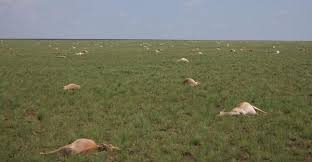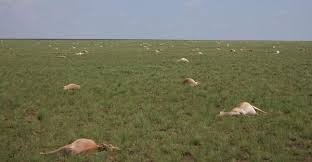
In a phenomenon that scientists are unable to explain, more than half of the world’s population of an endangered antelope died within two weeks earlier this year. More than 19,000 carcasses of antelopes were buried while more deaths are expected even as officials are no closer to determining the cause of the catastrophe.
Scientists say the actual figure will be significantly higher as many more carcasses were found but not counted as part of the burials even as there are reports of at least 150,000 adult saiga antelopes were buried during a fortnight in May. It is believed that hundreds of thousands of calves died too even though their count were not taken into account.
Antelopes are one of the most endangered species on the planet. Antelopes are known for their distinctive cylindrical snout, bulging eyes and curled horns as well as their ability to survive dramatic changes in temperature.
The estimated population of antelopes was between 250,000 and 320,000 in the world before the most recent die-off.
Kazakhstan, where 90% of the global population resides, is the only place in the world where most of the deaths have occurred.
Scientists say that the mass mortality defies understanding of how biological systems normally behave. Scientists say that the deaths cannot be attributed to any transmissible disease as the deaths occurred too quickly.
With no obvious signs of malnutrition the dead antelopes did not have any wounds or evident trauma on them that would point to poaching. No significant presence of toxins or poisoning by radiation were been found in the soil and water samples from the area. However activists based in Kazakhstan claimed that fuel from Russian rockets could be to blame.
However scientists believe that a bacterium called pasteurella already living in the throat of the animals is the most likely culprit of the deaths.
It is likely that an unidentified trigger caused it to change its character and “become nasty” although the bacteria normally remains dormant, said Prof Richard Kock from the Royal Veterinary College at the University of London . this triggering could have produced toxins that could have attacked the antelope’s organ systems and caused death within hours.
Kock however was skeptical about what triggered this change across the entire population. He believes that it must have been an environmental factor.
In the days before the die-off, during the calving period after the animals have shedded their protective winter coats, a temperature drop from 30C to -5C within 24 hours had occurred. But scientists also confirmed that similar temperature changes have occurred in previous years but such catastrophic affects were not witnessed.
With significant temperature rises in the region in recent years, the ongoing climate change could also have had an impact, Kock added. Scientists are also investigating any possible changes to vegetation and soil and the presence of toxins.
“It could all be down to timing. If you get your ducks all lined up in a row, something happens. Whatever it is, it has to be something that would affect all of them,” Kock said.
(source:www.theguardian.com)
Scientists say the actual figure will be significantly higher as many more carcasses were found but not counted as part of the burials even as there are reports of at least 150,000 adult saiga antelopes were buried during a fortnight in May. It is believed that hundreds of thousands of calves died too even though their count were not taken into account.
Antelopes are one of the most endangered species on the planet. Antelopes are known for their distinctive cylindrical snout, bulging eyes and curled horns as well as their ability to survive dramatic changes in temperature.
The estimated population of antelopes was between 250,000 and 320,000 in the world before the most recent die-off.
Kazakhstan, where 90% of the global population resides, is the only place in the world where most of the deaths have occurred.
Scientists say that the mass mortality defies understanding of how biological systems normally behave. Scientists say that the deaths cannot be attributed to any transmissible disease as the deaths occurred too quickly.
With no obvious signs of malnutrition the dead antelopes did not have any wounds or evident trauma on them that would point to poaching. No significant presence of toxins or poisoning by radiation were been found in the soil and water samples from the area. However activists based in Kazakhstan claimed that fuel from Russian rockets could be to blame.
However scientists believe that a bacterium called pasteurella already living in the throat of the animals is the most likely culprit of the deaths.
It is likely that an unidentified trigger caused it to change its character and “become nasty” although the bacteria normally remains dormant, said Prof Richard Kock from the Royal Veterinary College at the University of London . this triggering could have produced toxins that could have attacked the antelope’s organ systems and caused death within hours.
Kock however was skeptical about what triggered this change across the entire population. He believes that it must have been an environmental factor.
In the days before the die-off, during the calving period after the animals have shedded their protective winter coats, a temperature drop from 30C to -5C within 24 hours had occurred. But scientists also confirmed that similar temperature changes have occurred in previous years but such catastrophic affects were not witnessed.
With significant temperature rises in the region in recent years, the ongoing climate change could also have had an impact, Kock added. Scientists are also investigating any possible changes to vegetation and soil and the presence of toxins.
“It could all be down to timing. If you get your ducks all lined up in a row, something happens. Whatever it is, it has to be something that would affect all of them,” Kock said.
(source:www.theguardian.com)





